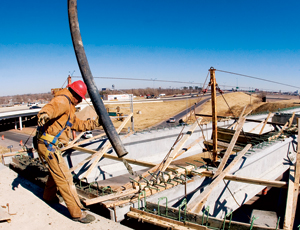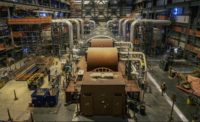President Barack Obama, speaking before signing his historic stimulus measure in Denver, proclaimed it to be the “largest investment in our infrastructure since Eisenhower built the interstate highway system.”
That may be so, but with most of the stimulus directed toward infrastructure, the news isn’t uniformly good. Just minutes before Obama spoke, Blake Jones, CEO of Namaste Solar Electric Inc., said “thousands of electricians and plumbers and carpenters...that have been laid off should consider joining us in the solar industry.”

Those comments suggested the diverging fortunes of the industry even now that the stimulus has passed. Highway and bridge construction should grow modestly, but nonresidential building construction will begin to turn toward cyclical lows. The stimulus package will cushion, not save, the buildings sector.
What is certain in a time of uncertainty, economists say, is that the industry will be much more public-works-oriented than at any time in recent history. While building construction in the 1980s was dominated by offices and stores, the 1990s saw that market sector shift toward hospitals, schools, churches and prisons. It stayed that way until recently.
The square-footage peak for nonresidential building occurred in 2000, at 1.9 billion square feet, and returned to a very high level again in 2007, at 1.7 billion square feet, notes Robert Murray, chief economist for McGraw-Hill Construction, the parent of ENR. With the worsening economy, that sector is moving toward “previous cyclical bottoms,” which occurred in 1982, when 1.1 billion square feet were completed, and 1992, when 935 million square feet were built.
Public works, especially highways and bridges, haven’t been subject to the ferocious cycles of the buildings market. For fiscal 2009, federal funding of highway and bridge construction stayed flat at $41 billion. Any potential surge will be undercut by falling state and municipal project contributions as financial problems reduce local spending. Instead of coming in flat, overall highway and bridge spending should grow a modest 5% in the next year, says William Buechner, chief economist of the American Road and Transportation Builder's Association. He considers that a normal year of growth.
While transportation projects have been used to counteract recessions, most recently in 1983, there’s “no experience” with quick starting such as is required now, says Buechner. “Of the money going to the state DOTs, half, or $18 billion, has to be obligated in 120 days.”
According to McGraw-Hill Construction, the stimulus measure will reverse previously forecast declines in highways, bridges and environmental work. Exactly what will happen with school buildings, a staple of the recent buildings market, is unclear. Instead of getting its own specific line item of funding in the stimulus measure, school renovations and modernizations may be funded from a pot of $50 billion or so for state and local school districts. But it has to compete with other badly needed school funding priorities, like jobs for teachers, at a time of shrinking revenue. “Given the fiscal stress experienced by the states, they may have more immediate needs,” says Murray.
Architects pushed for school funding as a stand-alone. “We would have preferred language that made it specific” that funds would be used for school rehabilitation, says Andrew Goldberg, chief lobbyist for the American Institute of Architects. “It’s a starting point.”
But for whom? Union leaders are acclaiming the stimulus package, and part of the stimulus contains funding for green economy training and apprenticeship programs. Jones of Namaste Solar Electric says his company was forced by the financial turmoil to implement a hiring freeze and cut spending; dozens of the company’s projects were put on hold. Now that the stimulus package has been signed into law, the pessimistic outlook has been injected with new hope, and Namaste plans to hire more workers.
�“This is how you rebuild America,” says Colorado Gov. Bill Ritter, Jr. (D). What happens if the recession drags out for years and unemployment rolls fill with electricians and plumbers unable to switch into green projects? Another stimulus better geared toward helping displaced craft workers get through the tummult may be needed.




Post a comment to this article
Report Abusive Comment